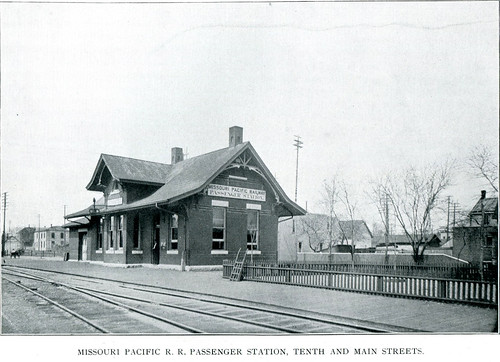Any town with a railroad was bound to have its share of characters. Joplin certainly had its share. In 1897, Arthur Harrold, an eighteen year old tramp, arrived in town with a curious collection of artifacts. Harrold told a Globe reporter that he hailed from New York City and had left the Big Apple eight years and ten months earlier to see the country. With him he carried a sack full of relics that rivaled the collection of the Smithsonian: fragments of rope used to hang Cherokee Bill; a petrified potato; spectacles given to him by the first settler of Texas; the bullet that killed General James McPherson; cartridges owned by Cherokee Bill and one of the Dalton boys; saws used by Noble Shepherd when he cut his way out of the St. Louis city jail; and letters from officials from all over the country certifying his presence in their cities.
Harrold’s journey was sparked by a wager that he could not travel 65,000 miles in a ten year period and save up $6,000. At the time of his arrival in Joplin, he had reportedly saved $5,382 that was deposited in a New York bank. As part of the wager, he was not allowed to beg, steal, or borrow on his journey. Should he fulfill his mission, Harrold was to receive $5,000 from the Police Gazette magazine plus $5,000 from New York World and Associated Press.
At around the same time, another character drifted into Joplin, but not one that the police wanted to see. “Kansas City Jack” was described as a “bum” who was not “meek.” Upon arriving in Joplin, Jack immediately raised a disturbance at one of the train depots. Officer Jack Winters was called and quickly collared Kansas City Jack. But the bum was not one to go quietly as it was a “continual fight all the way from the depot to the station house.” In the course of their journey, the officer knocked Jack down “about twenty times and was about tuckered out when he reached the jail.” His neat, clean police uniform was reduced to shreds as the officer arrived at the police station wearing “only a pair of shoes and a tired looking countenance.” This, according to the Globe, was “the sort of struggle every officer is reported to have who arrests Kansas City Jack.”
After he was processed and released, Jack did not stay out of trouble. At two o’clock in the afternoon, Deputy Marshal Fones discovered some bums were passing liquor through the jail window to prisoners inside the jail. Upon going outside, Fones found that Kansas City Jack was one of the main culprits. After a struggle, and Deputy Marshal Fone’s pants being destroyed in the process, Jack was back in jail.
If Fones expected the rest of the day to go smoothly, he was wrong. At five o’clock that afternoon, while Fones was talking to a friend on Main Street between Second and Third streets, a little boy named Ira Chubb ran up and told him that prisoners were escaping from the city jail. Fones, together with Officer Winters and Deputy Constable Hopkins, took off in hot pursuit. Their chase was made all the easier by a group of young boys who were following the escapees. The prisoners were captured at Third and Byers. Upon inspecting the jail, it was discovered that one of the prisoners was a “mechanical genius” who had managed to unlock the jail door using only a simple wire.
There was never a dull moment in early Joplin!



